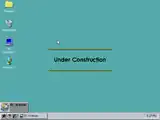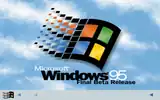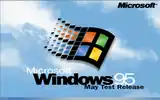Development of Windows 95
The development of Windows 95 (codenamed Chicago) began around March 1992,[1][2][3] just after the release of Windows 3.1. At this time, Windows for Workgroups 3.11 and Windows NT 3.1 were still in development at Microsoft. Windows 95 was eventually released to manufacturing on July 14, 1995, and generally to retail on August 24, 1995.
Background
During the initial design and planning of Windows 95 in 1992, Microsoft's strategy was to have a next generation, high-end OS based on Windows NT, namely, Cairo, and a low-end, consumer-focused one as an evolution of Windows 3.1. The latter strategy was to develop a 32-bit underlying kernel and filesystem with 32-bit protect mode device drivers in Windows for Workgroups 3.11, to be used as the basis for the next version of Windows, code named "Chicago". Cairo would be Microsoft's next-generation operating system based on Windows NT featuring a new user interface and an object-based file system, but it was not planned to be shipped before 1994 (Cairo would never be shipped, however, although elements from the Cairo project would eventually ship in late July 1996 in Windows NT 4.0, without the object-based file system, which would later evolve into WinFS).
Simultaneously with Windows 3.1's release, IBM started shipping OS/2 2.0. Microsoft realized they were in need of an updated version of Windows that could support 32-bit applications and preemptive multitasking, but could still run on low-end hardware (Windows NT, requiring 12 MB RAM and 75 MB disk space, did not). Initially, the "Chicago" team did not know how the product would be packaged. Initial thoughts were there might be two products, MS-DOS 7, which would just be the underlying OS, an evolution of the Windows for Workgroups 3.11 kernel, with a character mode OS on top, and a fully integrated graphical Windows OS. But soon into the project, the idea of MS-DOS 7 was abandoned and the decision was made to develop only an integrated graphical OS Windows "Chicago".
History
The Chicago project was led by Brad Silverberg, who, at that time, was senior vice president of the personal systems division at Microsoft. Microsoft's product plan looked as follows:
| Codename | Planned release date | Description | Released as |
|---|---|---|---|
| "Astro"[4] | September 1992 | Upgrade to MS-DOS 5.0, adding third-party tools to surpass DR-DOS 6.0 in features. | MS-DOS 6.0 |
| "Winball", "Sparta"[4] | October 1992 | Windows 3.1 with network support. | Windows for Workgroups 3.1 |
| "Jaguar"[4] | June 1993 | Next major release of real-mode MS-DOS, better integrating with Windows | MS-DOS 7.0 (Windows 95 MS-DOS Mode) |
| "Cougar"[4] | June 1993 | A 32-bit protected-mode MS-DOS kernel based on Windows' 386 enhanced-mode kernel | Windows 95 VMM |
| "Panther"[4] | June 1993 | The 32-bit Windows subsystem that could run on top of "Cougar" implementing a subset of Windows NT's Win32 API, but a superset of the Win32s API. | Windows 95 |
| "Rover"[4] | June 1993 | Windows for Mobile Computing, based on "Panther" | Windows for Pen Computing 2.0/WinPad (unreleased) |
| NT, NT OS/2, "Razzle" | July 1993 | A new version of Windows built from the ground up as an operating system for servers and workstations. | Windows NT 3.1 |
| "Bombay" | December 1993 | An update to Windows 3.1. | Windows 3.11 |
| "Snowball"[4] | February 1994 | Windows for Workgroups 3.1 with upgrades. | Windows for Workgroups 3.11 |
| "Daytona" | September 1994 | Successor to Windows NT 3.1. | Windows NT 3.5 |
| "Cairo" | July 1996 | An operating system with an object-based file system and a new user interface shell ported from Windows 95. | Elements of Cairo were shipped in Windows NT 4.0, minus the object-based file system. |
| "Cleveland",[5] "Nashville" | August 1996 | A new version of Windows 95 (build 999, also referred to as Windows 96) focusing on the tight integration of Windows and Internet Explorer was expected to be released, but has not been confirmed. | Cancelled; codename reused for Windows Desktop Update, which shipped with most of Nashville's features. |
Prior to the official release, the American public was given a chance to preview Windows 95 in the Windows 95 Preview Program. For US$19.95, users were sent a set of 3.5-inch floppy diskettes that would install Windows 95 either as an upgrade to Windows 3.1x or as a fresh install on a clean computer. Users who bought into the program were also given a free preview of The Microsoft Network (MSN), the online service that Microsoft launched with Windows 95. During the preview period Microsoft established various electronic distribution points for promotional and technical documentation on Chicago[6] including a detailed document for media reviewers describing the new system highlights.[6][7] The preview versions expired in November 1995, after which the user would have to purchase their own copy of the final version of Windows 95.
Notable beta milestones
Several Windows 95 betas were released before the final launch:
| Build | Description | Startup Screenshot | Desktop Screenshot |
|---|---|---|---|
| Build 58s | Build 58s was the first available build of Chicago, dated August 10, 1993. It introduced a Start menu prototype. It divided the functions of the Windows 95 Start menu up into three buttons. Future Chicago builds combined these three into the Start button still recognized today.
Build 58s included a new File Manager, Chicago Explorer, which remained relatively unchanged in the initial version of Windows 95 and in Windows NT 4.0. Build 58s still included Program Manager as found in Windows 3.1, although this application was supplemented by the new desktop and taskbar/Start menu designs. This build also introduced shortcuts (Chicago referred to them as Links) and native right click functionality, which Windows 3.1 lacked. It also introduced long file name support. |
_boot_screen.jpg.webp) |
|
| Build 73g | Build 73g is the next leaked build of Windows Chicago with a date of December 2, 1993, but the boot screen says November 1993 as its date. It is mostly the same as Build 58s, with a few UI tweaks and a network logon box at startup. | _boot_screen.gif) |
 |
| Build 81 | Build 81 follows build 73g. The date stamp is January 19, 1994, although the boot screen still says that it's from November 1993. The three start buttons are combined into one. However, the 8.3 filename limit makes the Start Menu item "Accessories" read "access~1". Programs running are only displayed on the taskbar. The briefcase UI was improved. The My Computer item is displayed when opened as :drives, Network as :network, and Control Panel as CONTROLS. |  | |
| Build 122 | Build 122 was the first version of Chicago to define itself as a Beta edition. There is a date stamp of June 9, 1994, with the boot screen saying the date of May 1994. This build includes a few minor improvements such as a different type of "Under Construction" background, the arrow being removed from the Start button, and the removal of some Control Panel items. There were also other interface updates: e.g. title of the My Computer, Control Panel, and Network windows are correct. The tips that would appear in the windows actually slide from right to left on the taskbar, starting from the clock and bouncing against the start button a few times. These get reset when opening-then-closing a window. | ||
| Build 189 | Build 189 is the first version to call itself Windows 95. The date stamp is marked September 21, 1994. The UI has been completely revamped to the final version’s look-and-feel, except for few small left-overs from Chicago. The Start menu also slightly differs from later builds of Windows 95, as there is actually color along the side.
A new setup bitmap introduced eight builds prior was used as the default background picture. This setup bitmap was similar to the one in the final build of Windows 95 during setup. |
||
| Build 224 | Build 224 is Windows 95 beta 2. It was not available in English. Only a date stamp of November 8, 1994, can be found as information on this build. | ||
| Build 347 | Build 347 is the Windows 95 "Final Beta Release". It was released in multiple languages. This version has a date stamp of March 17, 1995. |  |
|
| Build 468 | Build 468 is the May Test Release version of Windows 95, with a date stamp of May 11, 1995. The final startup – dubbed The Microsoft Sound – and shutdown sound made their appearances a few builds prior, after the Windows 95 "Final Beta Release". |  |
|
| Build 480 | Build 480 is a May Test Release dated May 24, 1995. It was released in two languages: English and German. | ||
| Build 490 (RC1) | Build 490 is a June Test Release dated June 8, 1995. It was the official Release Candidate 1 build of Windows 95. | ||
| Build 501 (RC1) | Build 501 is a June Test Release dated June 21, 1995. It was one of the final builds of Release Candidate 1. |
References
- "Plaintiff's Exhibit 1263" (PDF). Comes v. Microsoft. March 5, 1992.
- "Plaintiff's Exhibit 1308" (PDF). Comes v. Microsoft. May 7, 1992.
- "Plaintiff's Exhibit 1310" (PDF). Comes v. Microsoft. May 9, 1992.
- "Plaintiff's Exhibit 1285" (PDF). Comes v. Microsoft. April 9, 1992.
- Comes v. Microsoft 3208
- "Microsoft Windows Chicago Reviewer's Guide" (PDF). p. 282.
- Manes, Stephen (July 19, 1994). "PERSONAL COMPUTERS; Microsoft's New System Promises to Fix Glitches". New York Times.